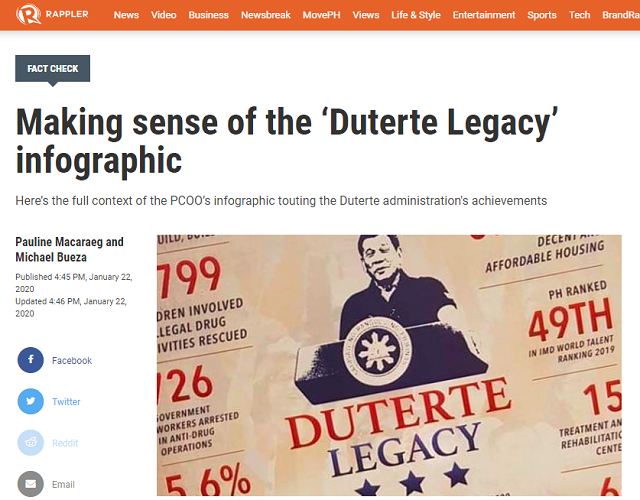Problematic numbers: Reporting the “Duterte Legacy”

WITH TWO more years to go, the Duterte administration seems overly concerned with drumming up publicity over its legacy. The Presidential Communications Operations Office (PCOO) launched a “Duterte Legacy” campaign on January 17, which Communications Secretary Martin Andanar said focuses on accomplishments in three key areas: peace and order, infrastructure and development and poverty alleviation.
Installing a photo exhibit in the Philippine International Convention Center, the PCOO also presented a single infographic representing the Duterte regime’s supposed achievements in huge numbers on hunger reduction, employment, airports and seaports built, and the arrest of drug personalities for Duterte supporters to share on social media.
Trumpeting its accomplishments is a key task of any communications team, including those in government. It is then up to journalists to check whether there is any truth to their claims.
Three Manila-based broadsheets (Philippine Daily Inquirer, The Philippine Star, Manila Bulletin) published a story on the legacy campaign the following day, reporting the event as programmed by government, and echoing the achievements touted by Cabinet officials. Subsequent reports quoted other government officials who either supported or criticized the campaign.
Primetime newscasts did not bother to report the launch and the information publicized by the campaign. Cable news channels, meanwhile, left it to the various public affairs programs on their respective schedules to deal with the legacy issue.
In ANC’s Early Edition on January 21, Christian Esguerra questioned Cabinet Secretary Karlo Nograles about the administration’s apparent “picking and choosing of favorable numbers,” while deliberately excluding the number of individuals killed in the drug war.
On the same day, The Chiefs on ONE News invited Sonny Africa, executive director of IBON Foundation, to discuss the accuracy of the socio-economic figures cited in the campaign. Africa said most of the numbers were “brazenly wrong” when cross-checked with available government data, such as the number of jobs created by the Build, Build, Build program and the number of airports in the country. He added that while presenting achievements in figures is not in itself problematic, these figures need to be factual and contextualized, qualities he claimed have been absent from the administration in the last three years.
Meanwhile, Rappler took the time to fact-check the figures supplied in the infographic. In “Making sense of the Duterte legacy infographic” published on January 22, Pauline Macaraeg and Michael Bueza pointed out problems in the data as well as in PCOO’s presentation. The report said not all the numbers in the infographic were the latest updated figures as claimed, and that these did not refer to official sources at all.
News reports which merely recorded campaign claims skipped the journalistic task of verification. The lapse makes it easy for the government spin to be ingrained in the public mind.
Leave a Reply